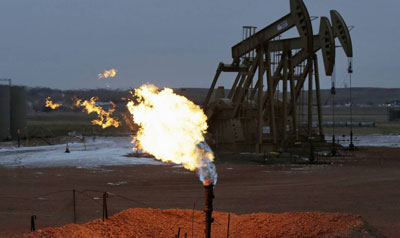Brent Crude Falls; Oil Prices End at Nearly Seven-Year Lows

Prices hit fresh seven-year lows on expectations that U.S. crude inventories rose
Brent crude dipped below $40 a barrel Tuesday in a selloff that has raised a worrisome possibility: that oil prices could be even lower next year than they have been in 2015.
In a volatile trading session oil prices closed at nearly seven-year lows, extending losses that have rattled global stock markets and raised fresh questions about oil producers’ ability to weather a prolonged rout.
Analysts and investors who initially thought prices would recover in the second half of 2015 now say they don’t expect any pickup until late 2016.
Many producers continue to pump barrels at a fast clip, defying predictions that low prices would lead to a significant slowdown in output. Wall Street banks are revising down their price forecasts and, in some cases, calling for lower average oil prices in 2016 than in 2015.
Rising inventories of crude oil and petroleum products world-wide are at the crux of the oil market’s weakness. In the U.S., stockpiles have risen for 10 weeks in a row at a time when supplies usually shrink at the onset of winter.
“That’s probably the biggest controversy about when the oil-price recovery begins, is that very high level of inventories,” said Ed Cowart,portfolio manager at Eagle Asset Management, which manages $32 billion. For sentiment in the oil market to turn more bullish, he said, “you’ll really need to see some indicators that supply and demand are really tightening up.”
Brent, the global benchmark, pared losses during intraday trading on Tuesday to end at $40.26 a barrel, down 1.2% on ICE Futures Europe. U.S. crude for January delivery slipped 0.4% to $37.51 a barrel on the New York Mercantile Exchange.
Down 30% from the start of the year, both contracts are trading at lows last hit in February 2009 during the financial crisis.
On Monday, both the U.S. and global oil benchmarks fell more than 5%, sending energy-company shares into a tailspin. Investors on Tuesday continued to unload shares of energy companies, which contributed to declines in broader stock indexes. The Dow Jones Industrial Average lost 162.51 points, or 0.9%, to 17568.00.
The U.S. Energy Information Administration on Tuesday cut its 2016 forecast for U.S. oil prices, saying they will average $50.89 a barrel, compared with $51.31 a barrel from a prior forecast. Bank of America Merrill Lynch in late November cut its 2016 U.S. price forecast to $48 a barrel from $53 a barrel.
Nymex crude has averaged $49.60 a barrel so far this year.
Oil prices have plunged in the past year as producers, especially in the U.S. and Middle East, have pumped oil at near-record rates, adding to global inventories.
The Organization of the Petroleum-Exporting Countries decided at its meeting last week to keep production robust despite low prices. A stronger dollar also has weighed on oil prices this year, making the dollar-denominated commodity more expensive for buyers using foreign currencies.
Analysts expect U.S. inventory data due Wednesday to show an 11th consecutive weekly increase in domestic crude stockpiles amid high output levels and slack demand for heating fuels due to moderate temperatures, according to a Wall Street Journal survey. Analysts also expect the U.S. to report growing inventories of gasoline and other petroleum products.
The American Petroleum Institute, an industry group, said late Tuesday that its own data for the same week showed that crude stockpiles fell by 1.9 million barrels, while supplies of refined products rose, according to industry participants.
The rapid increase in supplies of crude-oil and petroleum products has sparked some concern among traders that storage facilities in some parts of the world could run out of room. A lack of storage could cause prices to drop more sharply, as some buyers would be forced to step out of the market.
Traders will also watch the weekly EIA data for U.S. production estimates. While output has fallen from a multidecade peak in April as companies have cut spending, the decline has been slower than many investors expected, another factor weighing on prices.
The EIA said Tuesday that U.S. crude production fell by 60,000 barrels a day in November from the prior month to 9.2 million barrels a day. That is a slower pace of decline than in October, when production fell by 160,000 daily barrels compared with September, according to EIA estimates.
The agency also raised its forecast for U.S. crude-oil production this year to 9.33 million barrels a day, from its prior forecast of 9.29 million barrels a day. U.S. production has remained relatively high despite low prices as producers have become more efficient at drilling and new projects in the Gulf of Mexico started up.
The International Energy Agency and OPEC are due to release their monthly supply-and-demand outlooks later this week.
Some traders are reluctant to take any risks in this market until next week’s decision from the U.S. Federal Reserve on interest rates.
Higher interest rates could strengthen the dollar, which could push oil prices even lower.
“[Brent] is looking very isolated at the moment,” said Michael Nielsen, senior trader at Global Risk Management. “I am on the sidelines now until the Fed makes its decision.”
Source: WSJ – Brent Crude Falls; Oil Prices End at Nearly Seven-Year Lows





























